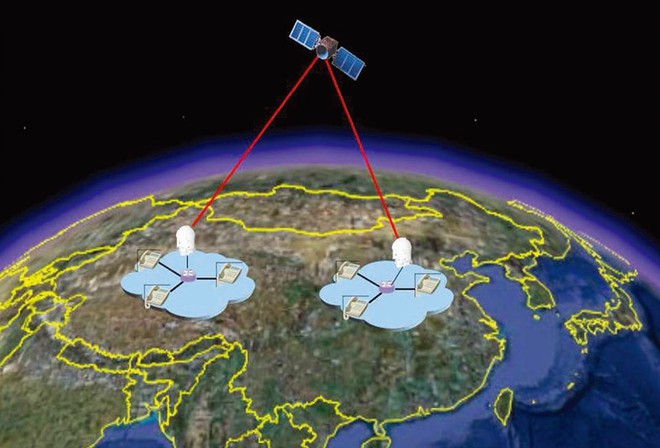This is why we should build quantum internet infrastructure in orbit
New research shows that with an array of 400 quantum satellites, we will "easily" have a global quantum internet.
The mysteries of the world are shared on the Internet
How did the Soviet Union nearly invent the Internet?
If you want to know how big the Disney empire is, look at how they manipulated the Internet to protect the movie Captain Marvel

The quantum internet has been an unfinished dream for many years; It works in theory, even though it uses technology to the extent that science has yet to explain it, but it's still just a dream for now. In fact, we still haven't been able to take advantage of the strange entanglement of photons and electrons to secretly send messages that only the two ends of the communication wire know.
Obviously, communication is useful in government operations and in the military, but industries that need to ensure security like banking, business contracts or even sensitive messages also need a system. confidential communication. The need is always present, and while looking for ways to realize it, perhaps this question should also be asked to the scientific and technical world:
How should we build a global quantum internet?
We get part of the answer thanks to the research effort of Sumeet Khatri and colleagues, who are now at Louisiana State University. They studied a variety of ways to build the quantum internet and came to the conclusion: to optimize costs, we need to build an array of quantum satellites in orbit, continuously emitting photons already in the entangled camp. ground. Simply put, the infrastructure that makes up the quantum internet will be beyond Earth.
A little background knowledge to build the building of knowledge.
What makes up any quantum communication system is the particle's entanglement. This is a phenomenon that occurs when two quantum particles exist, even if the distance between them is extremely large. Measure a particle to get the value, we will know the element of that particle immediately and will know immediately the state of the other particle. Einstein called this " bizarre activity at a distance ".

The first image of quantum entanglement.
Physicists often create "quantum entanglements" through the use of a pair of photons generated at the same place and at the same time. When sending two photons to different locations, the entanglement allows the two particles to be related, and by rotating them we can send messages in absolute safety.
The problem is that the tangled state is easy to dissolve. Any interaction between a photon and its surroundings can break the bond between the two particles. That's also why it's hard for satellites to shoot particles through the atmosphere or let particles travel through optical cables. When the photon interacts with an atom in the air or with a mirror in a cable, the entanglement factor disappears. It turns out that the maximum distance for the quantum entanglement to operate smoothly is only a few hundred kilometers.
So how to get the global quantum internet? One could consider the use of quantum repeaters - devices that receive and measure the quantum properties of a photon, then transfer those quantum properties into a new photon and then send it on. This process preserves the entanglement of the particle, allowing it to continuously jump through repeaters to reach its final destination. However, this technology is only experimental, it will probably be many years before it is ripe for commercialization.
Another way: create a pair of entangled photons in the Universe and then transmit them to two ground stations. Earth stations will inherit entanglement from the particle, allowing messages to be sent with an extremely high level of security.

In 2017, China's Micius satellite did a test proving that entanglement is still preserved during descent from orbit. It turns out that in this case, the photon can travel further than expected because it only needs to travel about 20 kilometers in the atmosphere, if the satellite flies high enough.

China's experimental quantum internet project opens up great potential.
Professor Khatri and his colleagues say that an array of satellites similar to Micius would be the best way to deploy the quantum internet. The key to secure communication: two ground stations must simultaneously see the satellite, in order to both receive the emitted entangled photon.
How high must the satellite fly? How many such satellites do we need? " Because satellites are so expensive right now, we'll need as few satellites as possible for long-term operation, " the team replied .
To test this idea, Khatri and colleagues created a model of an array of quantum satellites. They discovered that a number of trade-offs had to be made in order to have a smooth running system. For example, a small number of satellites flying at high altitude will have global coverage, but the higher the satellite, the more photons will be lost.
But if the satellite is flying low, the space for a satellite to move so that it can see both ground stations will be very modest. For low-flying satellite arrays, we will need a larger number of satellites, driving costs up too much.

One more question: Do we want to put 400 more satellites into orbit?
Based on these limitations, Professor Khatri said that the satellite array should have 400 and fly at an altitude of 3,000 meters. That is many times the requirements of the GPS system, when we only need 24 satellites to provide positioning services on the ground.
Even with 400 satellites, the distance between ground stations is limited to 7,500 km. That means that the distance of the two ends of the wire is limited to 7,500 km; send confidential messages to merchants in the city. Ho Chi Minh is fine, but if your girlfriend lives in Europe, you won't be able to take advantage of quantum entanglement to transmit love letters.
However, Professor Khatri and his colleagues said that the quantum internet with overhead satellites will still be more effective than repeaters that can only be separated by less than 200 km.
The quantum internet system will require huge investment. In the current economic situation, and based on the successes that the Micius satellite has had, the initial assessment shows that China has the potential to become a pioneer of quantum internet technology. They have been planning to implement this new technology in practice.
Europe and America are less interested in the internet of the future. But the situation will change if the quantum internet proves itself. Until then, the quantum race will be fierce.
Operate and exploit advertising by iCOMM Vietnam Media and Technology Joint Stock Company.
116 Thai Ha, Trung Liet Ward, Dong Da District, Hanoi.
Email: info@more.edu.vn
Editor in chief: Tran Vo
Tel: (+84) 903076053/7 Fax: (+84) 903030935